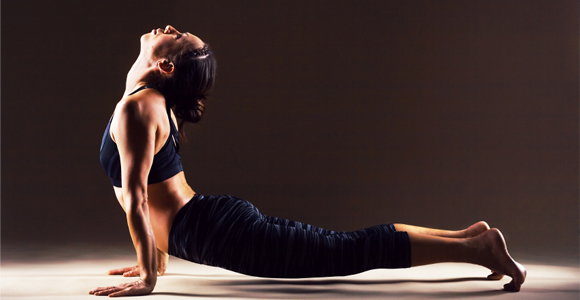Yoga is often perceived as a gentle, simple approach to movement that can be used to heal injuries, increase flexibility, and release tension in both the body and mind. While this is true, yoga can also be a physically demanding workout, with many of the postures appearing to be nearly impossible. With a few preparations, though, even the most difficult of poses can be achieved.
Planks
Planks are one of the most common exercise moves in all of fitness. In yoga, plank poses are often seen as transitions between other poses, as well as the main part of sun salutations. Planks are total body poses, whether you are on your hands, forearms or in a side plank. They use your core, shoulders, thighs and arms to strengthen and support your body. The best way to build strength for a plank pose is to modify it by bringing your knees to the ground. With your knees down, you'll be able to engage your core, squeeze your thighs, and support through your arms and shoulders as you build strength for the full version.
Inversions
Flipping upside down and supporting yourself on your hands or arms can be difficult, no matter what your fitness level. Often, it is not only strength and flexibility you need to work on, but also simply getting used to being upside down. To start, try a downward-facing dog. This will help to loosen up the shoulders and slowly transition you to inverting. In downward dog, lift one leg off the ground at a time. This will add to the instability and inverted posture. Once you feel steady, find a wall to balance against. With your hands or arms on the mat, slowly kick your legs up to invert.
Arm Balances
Arm balances can be intimidating, and they are difficult to get into and hold. Core strength, arm strength and props can make it easier to achieve these poses. Boat pose can be used to strengthen core muscles, which will help to hold you up. Poses like plank or chaturanga will help to build arm strength and alignment for many arm balances. Props can be used to prop you up under your feet, head, belly or legs, and they allow you to feel what it would be like in a balance, without adding the fear of falling to the ground.
Forward Folds
Sitting in a forward fold may appear to be relaxing and gentle, but if you have any tension in your lower back or hamstrings, these poses can be anything but comfortable. To release your legs and deepen your fold, try using a pillow or wall. If you are near a wall, prop your legs up against it and keep your back flat on the ground. This will help to release your hamstrings without causing pressure in your lower back. You can also sit on a pillow, cushion or yoga block to tilt your pelvis, lengthen your spine and fold deeper without adding tension.
Backbends
Opening into a wheel pose, upward dog or cobra might seem intimidating, especially if you have tightness in your back, but these are fantastic poses for balancing out hours of sitting still. The key to any backbend is opening your chest more than bending into your lower back. To build into a deeper backbend, try pressing your pelvis forward, engaging your core, and lifting your rib cage and chest away from your waistline. This will give you more space to deepen slowly into the pose without pinching your back.

Jessi Andricks isn't just passionate about healthy living, she's made healthy living her life. Through her training in Health Coaching, Yoga and Fitness, she is able to blend together the best of all worlds, creating innovative online wellness programs and Detox Yoga Workshops, as well as teaching daily yoga, barre and fusion fitness classes. Jessi uses her knowledge to help others live healthy, happy lives. Look for her upcoming book, Detox 101, and check out more at thehouseofhealthy.com.



